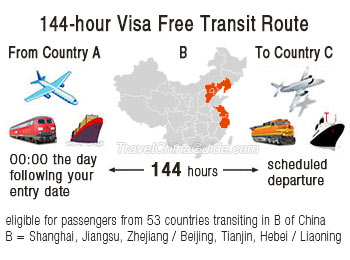China National Immigration Administration announced on December 17, 2024, the previous 72/144-hour visa-free transit policy offered to citizens of 54 countries was extended to 240-hour, as long as 10 days. This policy turned valid at the time being. At the same time, these travelers are allowed to move freely among different visa-free transit areas, not being limited to a certain transit area any more.
See details of China 240-Hour Visa-Free Transit
 |
1. 72/144-Hour Extended to 240-Hour
As long as 10 days, it’s generally enough for tourists to explore most popular travel destinations in China during the transit.
2. Cross-region Travel Allowed
Before, passengers can only stay in one single transit area. For example, if one transits visa-free in wider Beijing area, he or she could only stay within that region and is not allowed to travel beyond.
Presently, the region limitation has been lifted, which means one can travel visa-free among all the visa-free transit areas. For example, after visiting Beijing, he or she can travel onward to Xi’an, Shanghai, Chengdu, Zhangjiajie and more.
3. Eligible Ports Increased from 39 to 60
Some of the newly added ports are Chengdu Tianfu International Airport, Sanya Phoenix Airport, Zhangjiajie Hehua International Airport, Guiyang Longdongbao International Airport, Huangshan Tunxi International Airport, Yiwu International Airport, Nanning Wuxu International Airport, and Jinan Yaoqiang International Airport.
Note: In Guangdong Province neighboring Hong Kong and Macau, transit passengers can exit from any of the open ports, bringing great conveniences for passengers who want to make a side trip there, too.
4. Wider Transit Regions from 19 to 24
The allowed transit regions increased from 19 to 24, newly added Shanxi Province, Anhui Province, Jiangxi Province, Hainan Province and Guizhou Province. Among them, the whole Anhui, Hainan and Guizhou are eligible territories while Shanxi is limited to Tiayuan and Datong and Jiangxi Nanchang and Jingdezhen.
Meanwhile, in Guangxi, Nanning, Liuzhou and other 8 cities are included in; and Fujian, Hubei and Shaanxi Provinces become wholly eligible from previous partially eligible.
Creatively Plan an Itinerary to Travel Visa-Free to China
This policy makes visa-free visit to China possible among citizens of USA, Canada, UK and more.
For instance, in the past, if a visitor from USA wanting to travel around in Chinese Mainland, he or she must apply for a visa in advance. If taking advantage of the 144-hour visa-free transit, he or she can travel within only one transit area, like Beijing, or Shanghai. Now, he or she can travel freely among all the 24 transit areas, in which most popular travel destinations are included. What he or she needs to do is simply adjusting the flight schedule, to create an eligible 240-hour visa-free transit itinerary, instead of driving far to the Visa Center to apply for a visa before departure, saving money, time and energy.
To be specific:
To be specific:
1. fly from USA to any of the 60 eligible ports;
2. travel around among the 24 eligible regions;
3. on the way back to USA, make a stop in a third region, like Seoul or Tokyo. In this case, Hong Kong and Macao are also considered as third regions.
Onward Ticket to 3rd Territory Still Needed
This rule is essential and remains as before. Before boarding the flight to Chinese Mainland, one should have the onward ticket to the 3rd region ready in hand.